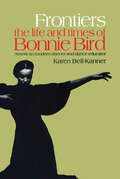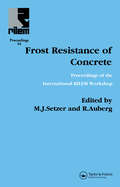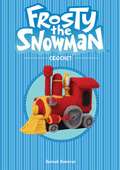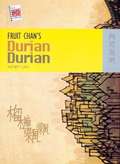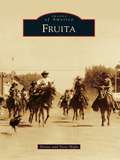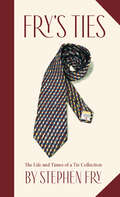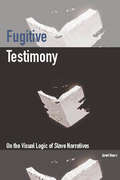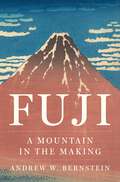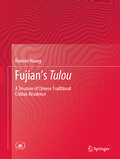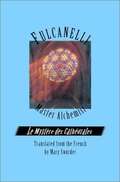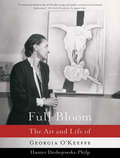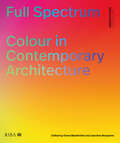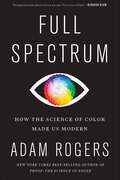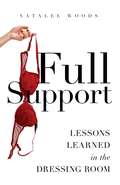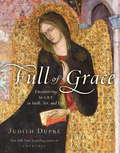- Table View
- List View
Frontiers of Computer Vision: 28th International Workshop, IW-FCV 2022, Hiroshima, Japan, February 21–22, 2022, Revised Selected Papers (Communications in Computer and Information Science #1578)
by Kazuhiko Sumi In Seop Na Naoshi KanekoThis book constitutes refereed proceedings of the 28th International Workshop on Frontiers of Computer Vision, IW-FCV 2022, held in Hiroshima, Japan, in February 2022. Due to the COVID-19 pandemic the conference was held online.The 24 full papers presented in this volume were thoroughly reviewed and selected from 63 submissions. The papers are organized according to the following topics: camera, 3D, and imaging; learning algorithm; object detection/segmentation; recognition/generation.
Frontiers of Computer Vision: 29th International Workshop, IW-FCV 2023, Yeosu, South Korea, February 20–22, 2023, Revised Selected Papers (Communications in Computer and Information Science #1857)
by Inseop Na Go IrieThis book constitutes refereed proceedings of the 29th International Workshop on Frontiers of Computer Vision, IW-FCV 2023, held in Yeosu, South Korea in February 20–22, 2023. This workshop is an annual event that brings together researchers in the field of computer vision and artificial intelligence to share their research results. The workshop was started 29 years ago as a way to strengthen networking and share research results between Japanese and Korean researchers, and it has since grown in scope and influence, so from 2017, the workshop became an international event. The 13 full papers presented in this volume were thoroughly reviewed and selected from 72 submissions in 8 countries. The papers are dealing with the following topics:basic theories related to image processing, computer vision, image media, and human interface, as well as all research fields in applied fields such as autonomous vehicle driving, robot automation, and image content recognition. Recently, topics related to application of medical, bio, and entertainment field applying artificial intelligence , and more.
Frontiers: American Modern Dancer and Dance Educator (Choreography and Dance Studies Series)
by Karen Bell-KannerFirst Published in 1998. Routledge is an imprint of Taylor & Francis, an informa company.
Frost Resistance of Concrete
by R Auberg M.J. SetzerThis book forms the proceedings of the international workshop to be held in Essen, Germany. This workshop summarises the conclusion of the technical committee's investigations into the resistance of concrete to freeze-thaw attack, specific in this to resistance with or without de-icing chemicals. It presents the RILEM recommendations on testing the
Frosty the Snowman Crochet (Crochet Kits)
by Hannah BusekrusThere must be some magic in this Frosty crochet book!Adapted from the beloved holiday special Frosty the Snowman, this kit contains all the magic you need to create the characters in amigurumi crochet figures! This instruction book provides step-by-step directions to make Frosty, Karen, Hocus Pocus, Professor Hinkle, Santa Claus, a squirrel, reindeer, the train to the North Pole, and more! Just crochet the hat for Frosty&’s head and begin to dance around! Download the templates here: https://www.thunderbaybooks.com/frosty-crochet-materials/
Frozen Planet II
by Elizabeth White Mark BrownlowACCOMPANIES THE LANDMARK SERIES NARRATED BY DAVID ATTENBOROUGHFind a world of wonder beyond the ice. 'Looking down at our planet from space it may come as a surprise how much of it is blanketed in snow and ice. These vast frozen wildernesses cover more than a fifth of the earth ... From the highest peaks to snow-bound deserts to alien worlds deep beneath the ice, they are home to an astonishing array of animals found nowhere else on earth.'David Attenborough, from the series.Frozen Planet II celebrates the surprisingly diverse worlds of ice - a world that is disappearing before our very eyes. Previously undiscovered stories, from chameleons giving birth on the frosty slopes of Mount Kenya to endangered Amur leopards in the Russian forest and killer whales hunting Weddell seals on ice floes in the Antarctic, shed new light on the beauty and the peril of the world's most fragile ecosystems. Behind-the-scenes insights explore the unique challenges of filming in these frozen worlds, where camera crew and wildlife alike brave the extreme conditions.With over 250 stunning full-colour photographs, Frozen Planet II reveals the wonders of the fastest-changing part of our planet, as we may never see them again.
Fruit Chan's Durian Durian
by Wendy GanThis book examines how Fruit Chan's Durian Durian sensitively portrays the unsettling seismic shifts affecting the inhabitants of both China and Hong Kong in a post-1997 context. The study covers different aspects of Durian Durian: its relation to the Hong Kong independent film sector and traditions of Hong Kong social realism; its representations of mainland Chinese women; and its representations of cross-border relations and issues of post-1997 identity for both inhabitants of Hong Kong and China. Gan argues that Durian Durian is an attempt to re-think Hong Kong and China as a single entity, a single imagined community in a post-1997 era. The film is an exploration of 'one country, two systems' not just in political but in spatial and affective terms. This is one of the first studies of Fruit Chan's work and presents him as one of Hong Kong's key filmmakers, worthy of serious critical study. Durian Durian is one of Chan's masterpieces and its study is of interest to anyone who is concerned with post-1997 realities in Hong Kong and China as visualized on film.
Fruit Chan's Made in Hong Kong
by Esther M. K. CheungThis tragic coming-of-age story follows three disillusioned local youths struggling to navigate Hong Kong public housing projects and late adolescence amid violent crime, gang pressure, and broken homes. Their personal friendships and family lives intersect with a mysterious fourth protagonist, a girl whose suicide haunts the other three throughout the film as they move toward their own premature ends. This 1997 film was the first in Chan's acclaimed "handover trilogy." Shot on a very low budget, utilizing excess film stock, amateur actors, and a crew of five, it marked the beginning of Chan's career as an independent film director.
Fruit Fizz Coasters
by Jenny HillWhat better way to keep ice-cold lemonades and fruit juices safe from pesky insects than crochet covers in acid lime green, clementine orange or the hue of homemade lemon squash? This project is also a great way to start working with beads. The pattern has been adapted with four designs, each using different sizes and styles of beads.
Fruita (Images of America)
by Steve Hight Denise HightWilliam Pabor arrived in Western Colorado before the advent of irrigation, and the land presented a barren and desolate sight. But he saw something entirely different. "In the spring of 1884, lying on the bare floor of a log cabin on the site of what is now the town of Fruita, I watched the moonbeams play on the Roan Cliffs and across Pinon Mesa," Pabor wrote. "The silence of centuries seemed resting upon the plain. . . . But visions of the possibilities of the future swept before me. I saw homes founded, I saw family circles gathered together. I saw vineyards and orchards, and rose-embowered cottages in which love and happiness and contentment abode. . . . I heard the merry voices of children yet to be born. I heard the singing of harvesters bringing in the sheaves of golden grain." Pabor soon turned vision into reality and founded the town of Fruita.
Fry's Ties: The Life and Times of a Tie Collection
by Stephen FryDiscover the story of a gentleman's most distinguished accessory, the necktie, with the inimitable Stephen Fry as your guide.In this utterly charming volume, Stephen Fry excavates his epic collection of neckties and shares the stories behind them. From the traditional "egg and bacon" colors of the Marylebone Cricket Club to the exuberant Dalmatian pattern of a 1980s Nicole Miller design, each tie tells a story. Interspersed amongst the collection are diagrams to aid in tying your own Half Windsor, Van Wijk, or Prince Albert Knot.The book expands on Fry's popular Instagram series, with additional, all-new content—including an essay about Fry's own necktie journey and a collection of snappy photos and illustrations of the ties themselves. This handsome little hardcover is more than an homage to a fashion accessory: it's an informative and witty tour of history, culture, art, and design.BELOVED AUTHOR: Stephen Fry is an icon in many domains, including humor, storytelling, and style. He is the ideal guide to the world of neckties, as knowledgeable as he is entertaining.PERFECT CONTENT FOR THE STEPHEN FRY FAN: For Fry's fans (especially those who first encountered him as the cool, collected, and always impeccably dressed butler Jeeves), this book is a perfect fit. DISTINCTIVE GIFT: This book will delight dads, granddads, brothers, and uncles—or anyone who likes to wear fancy neckwear with pride. BEAUTIFUL ARTWORK: Fry's excellent collection of ties is brought to life by photographer Clare Winfield and illustrator Stephanie von Reiswitz (whom readers may know and love from her popular Murder Most Puzzling series).Perfect for:Stephen Fry fansMen's fashion enthusiastsTie collectorsAnglophilesHumor readersFans of quirky popular history books
Fuck Yeah Menswear
by Kevin Burrows Lawrence SchlossmanIn your hands is an Amazonian blowgun full of deadly knowledge darts ready to be delivered straight to your cranium. You're about to begin a journey that will end in only one way--with you standing naked in an abandoned ravine watching as your old wardrobe slowly burns. Let this be your illustrated Iliad for dressing better. Don't sleep. Read Fuck Yeah Menswear. Refer to it. Cite it in your dissertation. Owning this book sends a very clear message to your peers, coworkers, and loved ones: "I'm trill as fuck."where the authors humorously discuss and dissect the finer points of the menswear world and the habits of the masculine fashion enthusiast. With biting breakdowns of must-have wardrobe essentials, the nuances of owning one's look, and the importance of living a "lifestyle," it's the hippest handbook available for any aspiring sartorialist.
Fuera Trastos: Simplifica Tu Vida En Tan Solo Un Fin De Semana
by Sarah Goldberg Sara Del Cueto¿Tu casa o tu piso están atestados de cosas y te está volviendo loca? ¿Necesitas deshacerte de toda esa basura y simplificar tu vida AHORA MISMO? ¿Te avergüenza que tus amigos (¡o tu madre!) vengan a casa porque lo tienes todo manga por hombro? Entonces este es tu libro. Únete a los miles de personas que ya se han descargado este libro superventas y que ya han conseguido simplificar su vida ¡en un solo fin de semana!Mira, yo también tuve una casa desastrosa hace tiempo. ¡Lo admito! Mi casa era un desastre con todas las cosas de los niños por medio, las de mi marido y los trastos que terminan apoyados en todas partes. ¡Me estaba volviendo loca! Pasaba una vergüenza terrible cada vez que venían los vecinos a casa, lo juro, me daba la sensación de que tenía cachivaches en todas partes.Pero eso se acabó. Decidí invertir UN FIN DE SEMANA de mi vida en deshacerme de los trastos inservibles para siempre. ¡Y funcionó! Ahora quiero ayudar a otros a que puedan hacer lo mismo, porque es MARAVILLOSO quitarse cacharros de encima y dejar tu casa como una patena. Además, puedes vender todo lo que te sobra en eBay y hacerte con un dinerito extra.Este libro te llevará, a lo largo de un fin de semana, desde la tarde del viernes a la tarde del domingo, de viaje y te guiará paso a paso hasta conseguir que tu casa vuelva a estar ordenada. Puede parecer una tarea complicada, pero no decaigas: no tienes nada que perder y las opciones de convertir tu casa en un lugar más vivible son muy elevadas.Además, al final del libro encontrarás recomendaciones sobre soluciones de almacenaje (cajas, cubos, estanterías, baldas, etc.) que te ayudarán en tu empresa de conseguir una casa libre de trastos.Que no te dé vergüenza tu casa atestada de cacharros. Empieza hoy, compra este libro, escoge un fin de semana y ¡fuera trastos!
Fugitive Cultures: Race, Violence, and Youth
by Henry A. GirouxFugitive Cultures examines how youth are being increasingly subjected to racial stereotyping and violence in various realms of popular culture, especially children's culture. But rather than dismissing popular culture, Henry Giroux addresses its political and pedagogical value as a site of critique and learning and calls for a reinvigorated critical relationship between cultural studies and those diverse cultural workers committed to expanding the possibilities and practices of democratic public life.
Fugitive Testimony: On the Visual Logic of Slave Narratives
by Janet NearyFugitive Testimony traces the long arc of the African American slave narrative from the eighteenth century to the present in order to rethink the epistemological limits of the form and to theorize the complicated interplay between the visual and the literary throughout its history. Gathering an archive of ante- and postbellum literary slave narratives as well as contemporary visual art, Janet Neary brings visual and performance theory to bear on the genre’s central problematic: that the ex-slave narrator must be both object and subject of his or her own testimony.Taking works by current-day visual artists, including Glenn Ligon, Kara Walker, and Ellen Driscoll, Neary employs their representational strategies to decode the visual work performed in nineteenth-century literary narratives by Elizabeth Keckley, Solomon Northup, William Craft, Henry Box Brown, and others. She focuses on the textual visuality of these narratives to illustrate how their authors use the logic of the slave narrative against itself as a way to undermine the epistemology of the genre and to offer a model of visuality as intersubjective recognition rather than objective division.
Fuji: A Mountain in the Making
by Andrew W. BernsteinA panoramic biography of Japan&’s iconic mountain from the Ice Age to the presentMount Fuji is everywhere recognized as a wonder of nature and enduring symbol of Japan. Yet behind the picture-postcard image is a history filled with conflict and upheaval. Violent eruptions across the centuries wrought havoc and instilled fear. Long an object of worship, Fuji has been inhabited by deities that changed radically over time. It has been both a totem of national unity and a flashpoint for economic and political disputes. And while its soaring majesty has inspired countless works of literature and art, the foot of the mountain is home to military training grounds and polluting industries. Tracing the history of Fuji from its geological origins in the remote past to its recent inscription as a World Heritage Site, Andrew Bernstein explores these and other contradictions in the story of the mountain, inviting us to reflect on the relationships we share with the nonhuman world and one another.Beautifully illustrated, Fuji presents a rich portrait of one of the world&’s most celebrated sites, revealing a mountain forever in the making and offering a meditation on the ability of landscape both to challenge and inspire.
Fujian's Tulou: A Treasure of Chinese Traditional Civilian Residence
by Hanmin HuangThis book analyzes a large number of typical tulou buildings and compact communities in detail, and painstakingly studies the way of life practiced in these communities, their defense systems, building techniques, spatial features, antithetical couplets culture, and historical origins. As such, it offers readers access to a unique treasure of traditional civilian residence, while also representing a valuable asset for architects and researchers in architectural history, cultural relics and fine arts.
Fulcanelli: Le Mystere des Cathedrales, Esoteric Intrepretation of the Hermetic Symbols of The Great Work
by Fulcanelli Mary SworderThis writing of Fulcanelli was written in the late 1920's in Paris France during the enlightenment years after WWI.
Full Bloom: The Art and Life of Georgia O'Keeffe
by Hunter Drohojowska-Philp"The definitive life of O'Keeffe." --Hilton Kramer, Los Angeles Times Georgia O'Keefe (1887?-1986) was one of the most successful American artists of the twentieth century: her arresting paintings of enormous, intimately rendered flowers, desert landscapes, and stark white cow skulls are seminal works of modern art. But behind O'Keeffe's bold work and celebrity was a woman misunderstood by even her most ardent admirers. This large, finely balanced biography offers an astonishingly honest portrayal of a life shrouded in myth. Some images in the ebook are not displayed owing to permissions issues.
Full Out: Leadership lessons from America's favourite coach
by Monica AldamaFrom the breakout star of Netflix's Cheer, a motivational and inspiring guide to becoming a champion in all areas of life.In Full Out, Coach Monica Aldama shares how she built one of the most successful and beloved cheerleading programs in America. Her uncompromising brand of discipline and consistency goes far beyond the mat - showing how the principles of building a winning team apply to personal goals, the corporate world, parenting and all aspects of life.There's a lot of talk these days about short cuts and life hacks, but what really counts is commitment and integrity, helping your friends, and improving with your teammates. Coach Monica shares deeply personal stories of triumph and tragedy from divorce and remarriage to her husband, her challenges as a young mother working more than full time, and her strenuous weeks on Dancing with the Stars. She shares surprising behind-the-scenes moments from the Cheer docuseries, and insights gleaned from more than two decades of pushing students to succeed. A true force and inspiration who has captured hearts around the world, Coach Monica will show you how to take command of your talent, make the most of your potential, and find your drive to win.
Full Out: Leadership lessons from America's favourite coach
by Monica AldamaFrom the breakout star of Netflix's Cheer, a motivational and inspiring guide to becoming a champion in all areas of life.In Full Out, Coach Monica Aldama shares how she built one of the most successful and beloved cheerleading programs in America. Her uncompromising brand of discipline and consistency goes far beyond the mat - showing how the principles of building a winning team apply to personal goals, the corporate world, parenting and all aspects of life.There's a lot of talk these days about short cuts and life hacks, but what really counts is commitment and integrity, helping your friends, and improving with your teammates. Coach Monica shares deeply personal stories of triumph and tragedy from divorce and remarriage to her husband, her challenges as a young mother working more than full time, and her strenuous weeks on Dancing with the Stars. She shares surprising behind-the-scenes moments from the Cheer docuseries, and insights gleaned from more than two decades of pushing students to succeed. A true force and inspiration who has captured hearts around the world, Coach Monica will show you how to take command of your talent, make the most of your potential, and find your drive to win.
Full Spectrum: Colour in Contemporary Architecture
by Elena Manferdini Jasmine BenyaminColour is architecture’s sharpest tool in the box. It has indexed everything from the feminine, cosmetic and vulgar to the pure, intrinsic and embodied. Colour has played a central role in the history of architecture. From the polychromy of the ancients to the great white interiors of high modernism. The figurative flourishes of postmodernism to the embedded sublime of contemporary building systems and facades. In contemporary architecture, colour has emerged as something powerful, both a mode of working and a political proposition. The second digital age has brought a fundamental shift in how architects engage colour. Employing the full range of colour puts forth a projective mode of action. It aids the democratisation of visual culture: opening the field to enable subjectivities, bring in new references and embrace new voices. This book explores the function of colour in contemporary architecture and argues it is not to present a vision of an idealised other world, but to prompt new imaginaries. Take in the full spectrum. Features: 100 Architects, Maya Alam, David Batchelor, Galo Canizares, Courtney Coffman, Fala Atelier, Marcelyn Gow, Sauerbruch Hutton, Sam Jacobs, Carolyn Kane, Guto Requena, Paulette Singley, Amanda Williams and Mimi Zeiger.
Full Spectrum: How the Science of Color Made Us Modern
by Adam Rogers"Informative and entertaining...Rogers is a seasoned raconteur, unreeling an eons-spanning tale with skill." —Wall Street JournalA lively account of our age-old quest for brighter colors, which changed the way we see the world, from the best-selling author of Proof: The Science of Booze From kelly green to millennial pink, our world is graced with a richness of colors. But our human-made colors haven&’t always matched nature&’s kaleidoscopic array. To reach those brightest heights required millennia of remarkable innovation and a fascinating exchange of ideas between science and craft that&’s allowed for the most luminous manifestations of our built and adorned world. In Full Spectrum, Rogers takes us on that globe-trotting journey, tracing an arc from the earliest humans to our digitized, synthesized present and future. We meet our ancestors mashing charcoal in caves, Silk Road merchants competing for the best ceramics, and textile artists cracking the centuries-old mystery of how colors mix, before shooting to the modern era for high-stakes corporate espionage and the digital revolution that&’s rewriting the rules of color forever. In prose as vibrant as its subject, Rogers opens the door to Oz, sharing the liveliest events of an expansive human quest—to make a brighter, more beautiful world—and along the way, proving why he&’s &“one of the best science writers around.&”* *National Geographic
Full Support: Lessons Learned in the Dressing Room
by Natalee WoodsLingerie is the foundation for every woman's wardrobe, but it's also where we feel the most pressure to be beautiful—and feel the most shame at falling short of impossible standards. Concerns about our age, body type, family expectations, jobs, and romantic partners crowd into the dressing room with us. The result is a bra that fits other people's standards instead of our own bodies. As a bra-fitter at a high-end department store for more than a decade, Natalee Woods watched women bravely facing down their fears and embracing what worked for them. FULL SUPPORT shares their stories.
Full of Grace: Encountering Mary in Faith, Art, and Life
by Judith DupréTwo thousand years ago, a girl from Nazareth was transformed by a simple "yes" into the Mother of God--the subject of sublime devotion, divisive controversy, and extravagant speculation. A mother and a virgin, a saint and a peasant, a woman both tragic and triumphant, Mary has held sway over the human imagination for centuries. Yet she has never felt as relevant to our everyday lives as she does today. In Full of Grace, Judith Dupré, the bestselling author of Churches, offers an intimate exploration of this beloved figure, now and through the ages. In a series of poignant stories and essays, Dupré examines Mary's artistic, cultural, and historical influence, and at the same time shows how Mary's human journey of love, compassion, grief, and humble strength inextricably connects her to our modern lives. Accompanied by a breathtaking visual feast ranging from classic Renaissance portraits to unexpected contemporary images, Dupré's text offers insights into the Virgin Mary as a mother and as a religious icon. Visits to the great shrines of Marian pilgrimage--Lourdes, Medjugorje, Fatima, and the Basilica of Our Lady of Guadalupe--underscore the author's journey to find Mary's meaning in her own life. In an essay about Mary in the Qur'an, we see how Mary, far from being an exclusively Catholic figure, emerges as one of the central women in Islam. Another piece details the author's travels in the Holy Land, a landscape wracked by religious strife but still overflowing with the spirit of generosity that Mary embodies. From Sudanese refugee camps to the painful reminders of Auschwitz, from the struggle of divorce to the challenges of raising a child with autism, we see how Mary's tenderness, bravery, and grace infuse the story of every mother, young and old. For men and women seeking to better understand their own life journey, this book looks at the many miracles, large and small, along the way.From the Hardcover edition.


